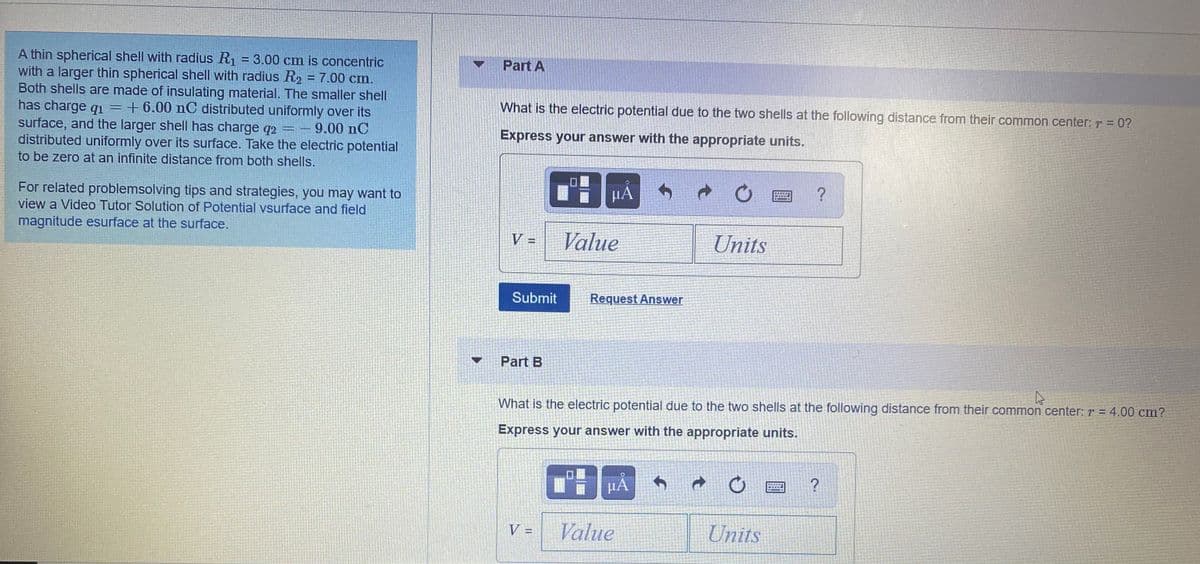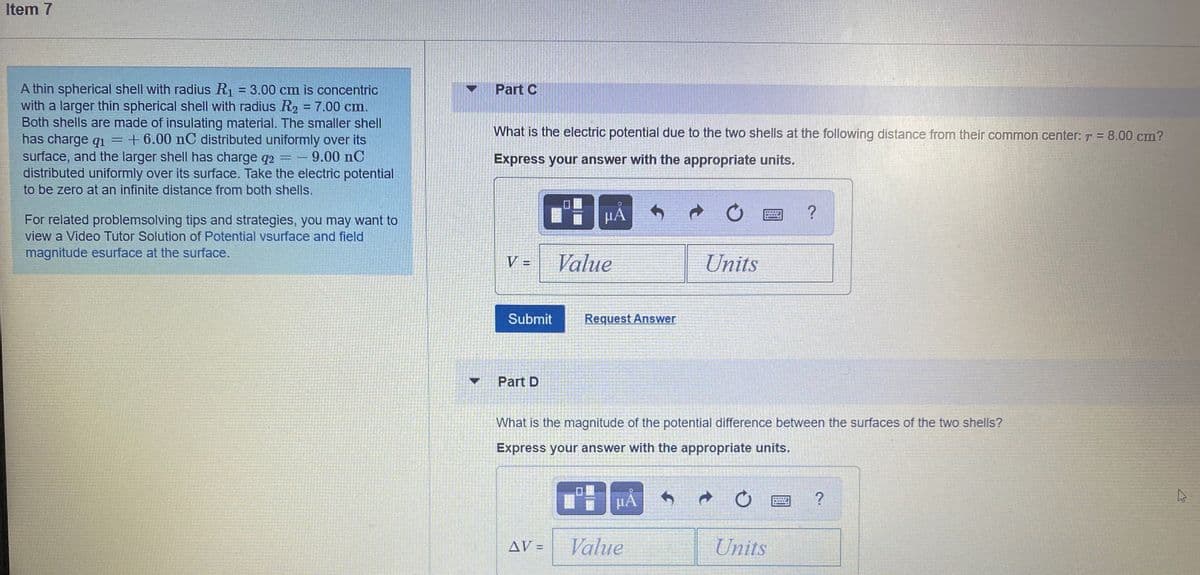A thin spherical shell with radius R, = 3.00 cm is concentric with a larger thin spherical shell with radius R2 = 7.00 cm. Both shells are made of insulating material. The smaller shell has charge qi surface, and the larger shell has charge q2 distributed uniformly over its surface. Take the electric potential to be zero at an infinite distance from both shells. Part A + 6.00 nC distributed uniformly over its What is the electric potential due to the two shells at the following distance from their common center: T = 0? 9.00 nC Express your answer with the appropriate units. HA For related problemsolving tips and strategies, you may want to view a Video Tutor Solution of Potential vsurface and field magnitude esurface at the surface. V = Value Units Submit Request Answer Part B What is the electric potential due to the two shells at the following distance from their common center: r = 4.00 cm? Express your answer with the appropriate units. V = Value Units
A thin spherical shell with radius R, = 3.00 cm is concentric with a larger thin spherical shell with radius R2 = 7.00 cm. Both shells are made of insulating material. The smaller shell has charge qi surface, and the larger shell has charge q2 distributed uniformly over its surface. Take the electric potential to be zero at an infinite distance from both shells. Part A + 6.00 nC distributed uniformly over its What is the electric potential due to the two shells at the following distance from their common center: T = 0? 9.00 nC Express your answer with the appropriate units. HA For related problemsolving tips and strategies, you may want to view a Video Tutor Solution of Potential vsurface and field magnitude esurface at the surface. V = Value Units Submit Request Answer Part B What is the electric potential due to the two shells at the following distance from their common center: r = 4.00 cm? Express your answer with the appropriate units. V = Value Units
Chapter7: Electric Potential
Section: Chapter Questions
Problem 60P: A metallic sphere of radius 2.0 cm is charged with +5.0C charge, which spreads on the surface of the...
Related questions
Question

Transcribed Image Text:A thin spherical shell with radius R1 = 3.00 cm is concentric
with a larger thin spherical shell with radius R2 = 7.00 cm.
Both shells are made of insulating material. The smaller shell
has charge qi =+6.00 nC distributed uniformly over its
surface, and the larger shell has charge q2 = - 9.00 nC
distributed uniformly over its surface. Take the electric potential
to be zero at an infinite distance from both shells.
%3D
Part A
%3D
What is the electric potential due to the two shells at the following distance from their common center: T = 0?
Express your answer with the appropriate units.
For related problemsolving tips and strategies, you may want to
view a Video Tutor Solution of Potential vsurface and field
HÁ
magnitude esurface at the surface.
V =
Value
Units
%3D
Submit
Request Answer
Part B
What is the electric potential due to the two shells at the following distance from their common center: r = 4.00 cm?
%3D
Express your answer with the appropriate units.
V =
Value
Units

Transcribed Image Text:Item 7
A thin spherical shell with radius R1 = 3.00 cm is concentric
with a larger thin spherical shell with radius R2 = 7.00 cm.
Both shells are made of insulating material. The smaller shell
has charge q1 =+6.00 nC distributed uniformly over its
surface, and the larger shell has charge q2 = – 9.00 nC
distributed uniformly over its surface. Take the electric potential
to be zero at an infinite distance from both shells.
Part C
%3D
What is the electric potential due to the two shells at the following distance from their common center: 7 = 8.00 cm?
Express your answer with the appropriate units.
For related problemsolving tips and strategies, you may want to
HÀ
view a Video Tutor Solution of Potential vsurface and field
magnitude esurface at the surface.
V =
Value
Units
Submit
Request Answer
Part D
What is the magnitude of the potential difference between the surfaces of the two shells?
Express your answer with the appropriate units.
HÀ
AV =
Value
Units
%3D
Expert Solution
This question has been solved!
Explore an expertly crafted, step-by-step solution for a thorough understanding of key concepts.
This is a popular solution!
Trending now
This is a popular solution!
Step by step
Solved in 3 steps with 2 images

Knowledge Booster
Learn more about
Need a deep-dive on the concept behind this application? Look no further. Learn more about this topic, physics and related others by exploring similar questions and additional content below.Recommended textbooks for you


Physics for Scientists and Engineers, Technology …
Physics
ISBN:
9781305116399
Author:
Raymond A. Serway, John W. Jewett
Publisher:
Cengage Learning

Principles of Physics: A Calculus-Based Text
Physics
ISBN:
9781133104261
Author:
Raymond A. Serway, John W. Jewett
Publisher:
Cengage Learning


Physics for Scientists and Engineers, Technology …
Physics
ISBN:
9781305116399
Author:
Raymond A. Serway, John W. Jewett
Publisher:
Cengage Learning

Principles of Physics: A Calculus-Based Text
Physics
ISBN:
9781133104261
Author:
Raymond A. Serway, John W. Jewett
Publisher:
Cengage Learning

Physics for Scientists and Engineers: Foundations…
Physics
ISBN:
9781133939146
Author:
Katz, Debora M.
Publisher:
Cengage Learning

College Physics
Physics
ISBN:
9781305952300
Author:
Raymond A. Serway, Chris Vuille
Publisher:
Cengage Learning

College Physics
Physics
ISBN:
9781285737027
Author:
Raymond A. Serway, Chris Vuille
Publisher:
Cengage Learning